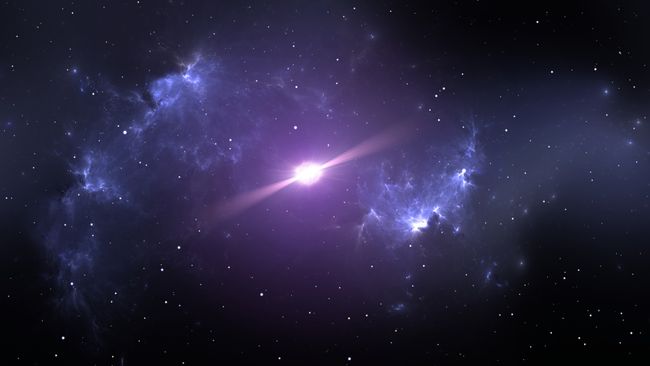Neutron Stars: Potential Pioneers as Dark Matter Detectors
The utilization of a neutron star as a dark matter detector heavily relies on its density.
Astronomers are still facing challenges in their quest to find dark matter, the enigmatic and elusive form of matter that dominates the mass of the universe. However, one astronomer suggests an alternative approach to searching for dark matter, rather than constructing expensive and massive experiments on Earth: looking towards the stars.
There are multiple lines of independent evidence that indicate the existence of dark matter. There is something that keeps stars confined within galaxies, despite their immense speeds. There is something that keeps galaxies contained within clusters, despite their excessive motion. There is something that causes the path of light to bend around massive objects. There is something that initiated the formation of the universe’s large-scale structure long before normal matter had the opportunity.
All of this “something” is currently categorized as dark matter, and the majority of scientists believe that dark matter is a novel type of particle that is not currently accounted for in the Standard Model of particle physics. It eludes direct detection because it has minimal, if any, interaction with light or normal matter.

In this image, streams of dark matter particles can be seen traversing through every corner of the galaxy, including the room you are currently occupying. Despite their omnipresence, these particles remain invisible and have eluded detection thus far. Over the past few decades, scientists have constructed massive laboratories on Earth in an attempt to capture a fleeting interaction with a dark matter particle, but their efforts have been in vain.
However, Thong Nguyen, an astronomer affiliated with the Academia Sinica in Taiwan, has highlighted in a paper published on the preprint database arXiv that nature possesses its own dark matter laboratories, which are far more potent than our own.
According to the conventional understanding of dark matter, it begins to aggregate in the early stages of the universe, well before regular matter does. Galaxies, which constitute less than 20% of the total mass in the cosmos, are essentially clusters of illuminated matter that have fallen into the gravitational wells created by dark matter. Consequently, the core of each galaxy should contain a substantial amount of dark matter, with densities potentially thousands of times greater than those found in the vicinity of our solar system.
Therefore, if we aspire to embark on a quest for dark matter, we will encounter significant challenges if we confine ourselves to Earth-based experiments due to the relatively low density of local dark matter. Conversely, it is impractical to dispatch an experiment to the galactic center, situated 25,000 light-years away. So, how can we directly investigate the presence of dark matter in that region?
Nguyen proposes that neutron stars, the remnants of massive stars following a supernova explosion, hold the key. Neutron stars, second only to black holes in terms of density, compress two to three times the mass of the Sun into a volume smaller than that of Manhattan. Their densities are so extreme that they can be likened to atomic nuclei spanning a mile in diameter. Any further compression would cause them to collapse into black holes.
The density of a neutron star plays a crucial role in its potential as a dark matter detector. While the interactions between dark matter and regular matter are expected to be infrequent (otherwise, we would have already detected dark matter), they do not have to be completely nonexistent. If there is even a small, rare interaction between these two types of matter, it is more likely to occur within a neutron star due to the abundance of material available for interaction.
Neutron stars can be found throughout the galaxy, but they are particularly abundant in the core where stellar activity is concentrated. The core of the galaxy provides a greater amount of material for star formation and facilitates more interactions, resulting in higher rates of star formation. Consequently, numerous remnants such as neutron stars are left behind. In fact, it is possible that there are up to a thousand neutron stars within a few light-years of the galactic center.
If dark matter interacts with normal matter, its encounters with neutron stars will result in numerous interactions that lead to energy loss. Over millions of years, a significant accumulation of dark matter can occur within neutron stars. The high density of dark matter within these stars is susceptible to annihilation, where two dark matter particles interact and mutually destroy each other, transforming into other particles in the process. These newly formed particles, such as neutrinos, can then escape from the neutron star.
On our planet, we possess various neutrino telescopes, such as the IceCube Neutrino Observatory located at the South Pole in Antarctica. Nguyen utilized publicly available data from these telescopes to investigate whether there was an excess neutrino signal originating from the galactic center. Although conclusive evidence for the existence of dark matter was not found, this study enabled the establishment of limitations on the ability of dark matter to interact with normal matter through this particular process.
While our comprehension of dark matter remains incomplete, concepts like these, particularly the utilization of nature as a testing ground, contribute to narrowing down the search and potentially uncovering the true nature of this enigmatic particle.
This article is republished from SpaceCom under a Creative Commons license. Read the original article.
Do not forget to share your opinion with us to provide you with the best posts !



0 Comments